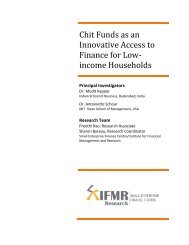Government of India Volume I: Analysis and Recommendations
Government of India Volume I: Analysis and Recommendations
Government of India Volume I: Analysis and Recommendations
Create successful ePaper yourself
Turn your PDF publications into a flip-book with our unique Google optimized e-Paper software.
NOTES OF DISSENT<br />
6. The present arrangement is that while the Central <strong>Government</strong> determines the policy<br />
for FDI, RBI, in consultation with the Central <strong>Government</strong> makes rules in relation<br />
to other capital flows. This arrangement has worked well <strong>and</strong> even the U.K. Sinha<br />
Working Group has not suggested any change to this basic arrangement. For the<br />
reasons enumerated above, this basic arrangement must be allowed to continue.<br />
18.4.2. Financial Regulatory Architecture<br />
1. The Report proposes (See Chapter 14.4) that: “the financial regulatory architecture<br />
suited for <strong>India</strong>n conditions should consist <strong>of</strong> seven agencies” which will include:<br />
◮ “Agency #1: A central bank that does monetary policy <strong>and</strong> enforces the consumer<br />
protection <strong>and</strong> micro-prudential provisions <strong>of</strong> draft Code in the fields<br />
<strong>of</strong> banking <strong>and</strong> payments”<br />
◮ “Agency #2: UFA which enforces the consumer protection <strong>and</strong> micro-prudential<br />
provisions <strong>of</strong> the draft Code in all finance other than banking <strong>and</strong> payments”<br />
The proposal therefore is that RBI will only regulate <strong>and</strong> supervise banks <strong>and</strong> payment<br />
system <strong>and</strong> that NBFCs <strong>and</strong> Housing Finance Companies(HFCs) will be regulated<br />
<strong>and</strong> supervised by UFA.<br />
2. I believe that it is essential that NBFCs <strong>and</strong> HFCs should be regulated by the same<br />
regulator as regulates the banks i.e., RBI. My reasons are as under.<br />
3. NBFCs are currently regulated <strong>and</strong> supervised by RBI. HFCs are currently regulated<br />
<strong>and</strong> supervised by National Housing Bank (NHB) which is a 100% subsidiary <strong>of</strong> RBI.<br />
Under the National Housing Bank (Amendment) Bill 2012 which is before the St<strong>and</strong>ing<br />
Committee on Finance <strong>of</strong> the Parliament, it is proposed that the ownership <strong>of</strong><br />
NHB will pass to <strong>Government</strong> <strong>and</strong> that regulation will pass to RBI with supervision<br />
remaining with NHB. The transfer <strong>of</strong> regulation is considered necessary since banks<br />
also do housing finance activity, the relative portfolio sizes being banks – 64% <strong>and</strong><br />
HFCs – 36%. There are currently 54 HFCs with a total asset size <strong>of</strong> Rupees 335,000<br />
crores which represents roughly 4.1% <strong>of</strong> the total asset size <strong>of</strong> all scheduled commercial<br />
banks.<br />
4. NBFCs are also engaged in substantially the same activity as banks. They are asset finance<br />
companies, infrastructure finance companies, micro-finance companies <strong>and</strong><br />
investment companies. They rely upon bank finance <strong>and</strong> are significant competitors<br />
<strong>of</strong> banks, particularly in the retail banking sector. Individually <strong>and</strong> collectively<br />
they are significant players in the financial system as shown below:<br />
◮ There are 12,348 NBFCs registered with RBI <strong>of</strong> which only 265 accept public<br />
deposits.<br />
◮ The total assets <strong>of</strong> NBFCs aggregate to Rupees 1,038,000 crores which represents<br />
roughly 12.7% <strong>of</strong> the total assets <strong>of</strong> all scheduled commercial banks.<br />
◮ There are 376 systemically important NBFCs with assets which aggregate to<br />
Rupees 923,000 crores, representing roughly 11.3% <strong>of</strong> the total assets <strong>of</strong> all<br />
scheduled commercial banks.<br />
◮ There are 42 NBFCs which have total assets in excess <strong>of</strong> the smallest scheduled<br />
commercial bank <strong>and</strong> 2 NBFCs which have total assets in excess <strong>of</strong> the smallest<br />
Public Sector bank.<br />
5. As the Report points, (See Chapter 1.5.2) difficulties are created in addressing finance<br />
regulation on a holistic basis, when there is the rise <strong>of</strong> a rapidly growing<br />
shadow banking sector. As most knowledgeable commentators have pointed out,<br />
154 FINANCIAL SECTOR LEGISLATIVE REFORMS COMMISSION



